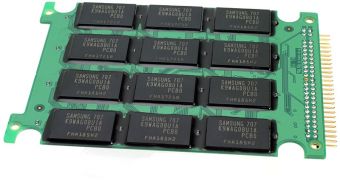Intel has launched its miniature Z-P140 PATA solid-state disks just before this year's Consumer Electronics Show in Las Vegas. Both tiny and energy-efficient, the drives are suitable for the upcoming generations of ultra-mobile PCs and Mobile Internet Devices (MIDs) that are expected to kick in soon.
It is true that sizes of 12x18x1.8mm and power consumption levels of 1.1mW while idle and 300mW during read/write operations would make any SSD designer turn green with envy, but in fact, Intel is way beyond schedule when it comes to pure performance and storage capacity. For instance, the maximum storage capacity offered by Intel goes as much as 16 GB with read/write speeds of just 40MB/s and 30MB/s respectively.
Intel's current offering is not enough, and the company is attempting to update its products with new multi-level cell-based NAND chips, that will be used in the upcoming models of 1.8-inch and 2.5-inch solid-state drives. Intel's NAND Products Group chief Troy Winslow claimed that the drives will arrive on the market in capacities ranging from 80GB to 160GB, which is ten times the company's current offering.
More than that, Intel will implement the highest available SSD technology into its new products. For instance, it will include Samsung's technology in order to deliver read speeds of 100MB/s and write speeds of 70MB/s.
"When Intel launches its...products, you'll see that not all SSDs are created equal," Winslow added. "The way the SSDs are architected, the way the controller and firmware operates makes a huge difference." Intel's solid-state drives will also use the Serial-ATA-II interface, in order to deliver higher data transfer rates.
NAND flash drives are getting more and more popular, yet they come at an extremely high price tag as compared to the conventional spinning platters. For instance, a 64 GB solid-state drive can reach as much as $999. However, Intel is confident that prices will continue to fall as the MLC technology is getting perfected.
"Price declines are historically 40 percent per year," Winslow stated. "And in 2009, a 50 percent reduction, then again in 2010."

 14 DAY TRIAL //
14 DAY TRIAL //